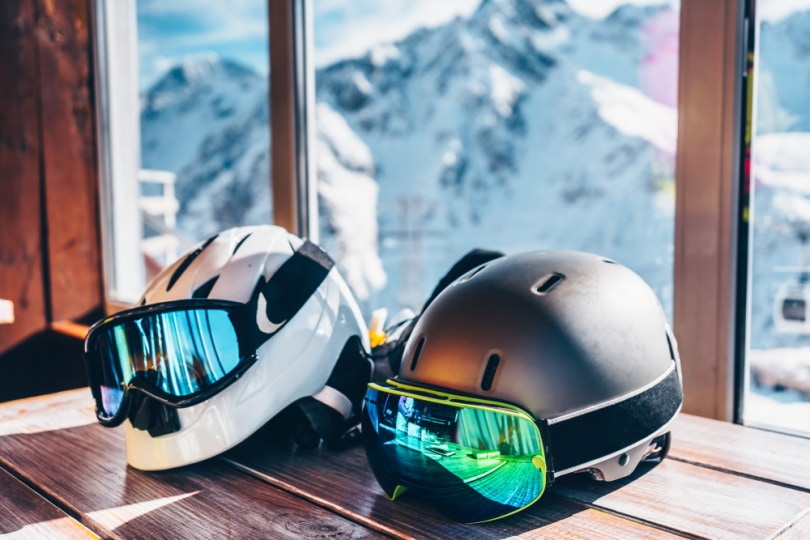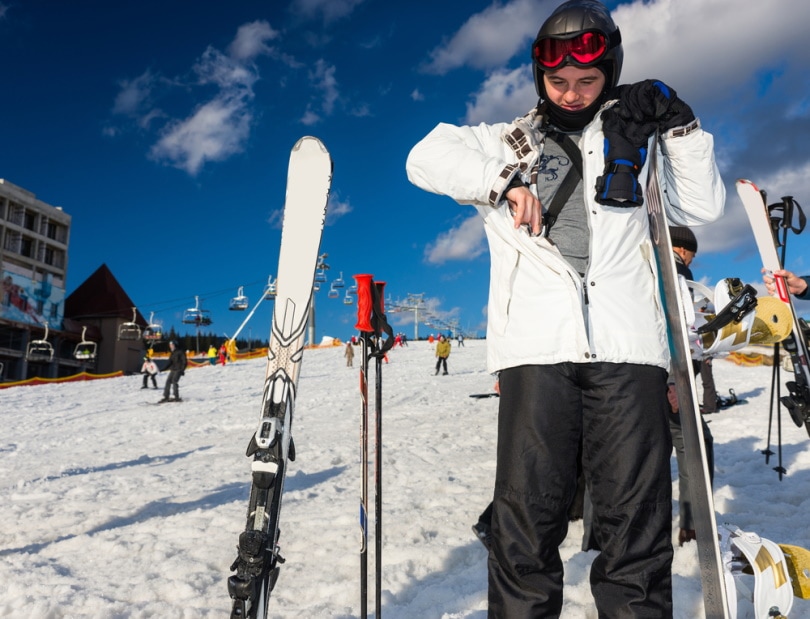How to Choose Ski Goggles – 14 Top Tips
Last Updated on

The weather can be challenging and unpredictable in the mountains, so you must have the correct eyewear to keep your eyes safe from the elements. Figuring out where to start when buying ski goggles isn’t easy.
It feels like there are countless options, and at first glance, they all look pretty similar. So, we have put together 14 tips on how to choose the best ski goggles for you, whatever the conditions.

The Top 14 Tips on How to Choose Ski Goggles
1. Do Your Research in Advance

Don’t leave finding the perfect goggle until the very last minute or, even worse, until you’re at the ski resort. Choosing the wrong pair of goggles can be uncomfortable and ruin the fun early, but they can also put you in danger. So, treat them like the important piece of equipment they are.
Figure out what your budget is and go from there. You want to find the goggles that offer the best features within your budget. Go into stores, speak to the people who work there, or use the internet to your advantage. A lot of the manufacturers provide details about their products on their websites.
2. What Am I Looking For?

Arguably, the lens is the most important part of the goggles; everything else is either about fashion or a support system to the lenses. So, start your research with the lenses. Check out the manufacturer’s websites; these will give you a good idea of what you need if you are going into this feeling clueless.
3. Lens Shape

There are two lens shapes: cylindrical and spherical. There are pros and cons to both, and we have outlined them below:
- Cylindrical Lenses: These are the cheaper of the two options because they are cut from a flat sheet and fitted into the goggle frames, this causes them to curve. Distortion can occur in your peripheral vision, which increases eye fatigue. As the lenses are flexible and easy to remove from the goggles, they are cheaper to replace. Cylindrical goggles are ideal for people who are watching their budget and need a pair of goggles for low light conditions.
- Spherical Lenses: Spherical lenses are more expensive thanks to their more complex shape; they curve not only left to right but also top to bottom. Simply, unlike cylindrical lenses, they are cut from a ball shape, not a flat sheet. This means they offer a wider field of vision, there is no distortion in the periphery vision, and they are less prone to fogging up because of the large volume frames which offer better ventilation than cylindrical lenses. The cost could be off-putting; however, if your budget allows, they are the better option as that cost buys you better quality.
4. Choose the Right Lens Tint

The goal of a lens tint is to provide a strong combination of depth perception, contrast, color definition, eye fatigue protection, and to offer the correct Visible Light Transmission (VLT) for the conditions you enjoy skiing in. So, the key point here is identifying when you enjoy skiing because the time of day and the conditions will play a pivotal role in your decision.
VLT exists on a scale of 0%–100%. The lower the VLT rating, the less light the lens will allow in, which you would wear on sunny days. Higher VLT lenses mean more light is allowed in, which you would wear on overcast days. The color of the lens will determine the performance of the goggles. Adding a mirror finish to the lens tint will also reduce the sun’s glare on bright days.
- Amber/ Yellow/ Gold Lenses: These colors work best in low, moderate, and variable light conditions by filtering out blue light to emphasize shadows in the snow so you can see bumps better. Other colors that work well in low light conditions are light rose and rose copper. A rose tint is softer than yellow and therefore softer on the eyes. This does, however, mean they are unsuitable for bright sunlight.
- Copper/ Dark Brown/ Dark Gray/ Dark Green: Darker colors will increase contrast and keep your eyes more comfortable in bright light. A darker tint like brown will reduce light and the sun’s glare. It means it isn’t very useful on overcast days, but it will still perform well overall.
- Clear Goggles: Clear lenses tend to come with UV protection and are worn at sunset or nighttime since they have the highest VLT rating.
- Other Tints to Consider: A mirror coating lowers the VLT of the lens by reflecting the sunlight. It might be worthwhile considering photochromic lenses which are usually available in gray and brown. These lenses react to light changes, becoming lighter or darker automatically.
5. Interchangeable Lenses

Interchangeable lenses come in the options of clip-in or magnetic to make the switch between them smoother. You might find yourself leaning into interchangeable lenses if you enjoy going out at different times of the day or in differing weather conditions. If you find you need varying protection or VLT ratings from your lenses that one lens just cannot accommodate, interchangeable lenses may be for you.
6. Anti-fog Features

Pick goggles with double lenses; this will ensure condensation does not form when your warm breath makes contact with the cold lenses. A good anti-fog coating is essential, especially if you enjoy going out in warmer weather.
7. Ventilation

Ventilation plays a key role in helping your anti-fog coating do its job. Vents increase the airflow through the frame and are usually placed along the sides, top, and bottom. Wider vents will do a better job than the narrow ones, but a consequence of this is your face will be colder in harsher climates.
More expensive goggles will utilize better materials and airflow systems to reduce the risk of fogging. Some goggles have a small fan to draw the moist air out of the goggle. These are a lightweight addition, but they do require a AAA battery.
8. Polarized Lenses

Polarized lenses reduce glare and protect you from eye fatigue. One of the main advantages of polarized lenses is they simultaneously work well in low and bright light conditions. This also means you don’t have to carry multiple lenses with you. However, be aware because polarized lenses are usually made with a darker tint, they are not ideal at the end of the day.
9. Ultraviolet Light Protection

There are two types of UV light: UVA, which is associated with skin aging, and UVB, which is associated with skin burning. It is important to get a lens that will protect you from the damage that can be caused by both; too much exposure can cause something called photokeratitis, which is a sunburn to the eyes.
10. Check the Fit

Make sure the goggles fit both with a helmet on and off. Many goggles come with an elasticated strap with sliding adjusters, which will allow you to change their fit. You want to make sure it is comfortable and easy to adjust.
11. Glasses? No Problem

If you wear glasses, make sure the goggles fit over them comfortably. There is also the option to get prescription inserts for the goggles that accept them, which is worth looking into as an alternative.
12. Safety Is Important

When it comes to eye safety, the best choice for your goggles is polycarbonate or Trivex lenses. They are more impact-resistant, lighter, and thinner than other plastic lenses. There are pros and cons to both of these options, for example, polycarbonate is 10% thinner than Trivex, while Trivex is 10% lighter. However, they do differ in cost, with polycarbonate coming out cheaper and also available in a variety of lenses.
13. Special Features

A scratch-resistant coating will prolong the life of your goggles. Some expensive goggles will have GPS systems that can show location, speed, jump stats, altitude, and distance in real-time on the inside of the goggles. Some even have Bluetooth options to connect to your phone so you can receive text messages and phone calls through the goggles.
14. You Don’t Have to Be Fancy

Sometimes prevention is better than a cure, which a new pair of goggles could end up being. This is where your research comes in handy. Maybe you don’t need a new pair of goggles with a fancy ventilation system because you’re guilty of putting your goggles on your head when you aren’t using them. Doing this will cause your goggles to fog up, because heat rises, making the top of your head the perfect place for condensation to occur when this heat meets the cold lenses.
Always remember to place your goggles in a protective case or soft pouch when you aren’t using them. This has the added bonus of reducing the likelihood that they will get scratched too.

Last Thoughts
Choosing the best goggles requires some work on your part, but the best place to start is: what do you need from your ski goggles and how much are you willing to spend on them? Once you have your needs and budget worked out, you have a starting point for your research.
We hope these tips will make your search a little easier so you can get out on those slopes sooner rather than later!
Featured Image Credit: Zoom Team, Shutterstock
Table of Contents
- The Top 14 Tips on How to Choose Ski Goggles
- 1. Do Your Research in Advance
- 2. What Am I Looking For?
- 3. Lens Shape
- 4. Choose the Right Lens Tint
- 5. Interchangeable Lenses
- 6. Anti-fog Features
- 7. Ventilation
- 8. Polarized Lenses
- 9. Ultraviolet Light Protection
- 10. Check the Fit
- 11. Glasses? No Problem
- 12. Safety Is Important
- 13. Special Features
- 14. You Don’t Have to Be Fancy
- Last Thoughts
About the Author Kerry-Ann Kerr
Related Articles:
How to Collimate Binoculars: 9 Expert Tips
How to Clean a Rifle Scope: 8 Expert Tips
Can You Use Binoculars to Look At Stars? How to Choose the Right Pair
How to Choose Binoculars for Bird Watching: 10 Expert Tips
How to Clean a Refractor Telescope: Step-by-Step Guide
How to Clean a Telescope Eyepiece: Step-by-Step Guide
Monocular vs Telescope: Differences Explained (With Pictures)
What Is a Monocular Used For? 8 Common Functions
